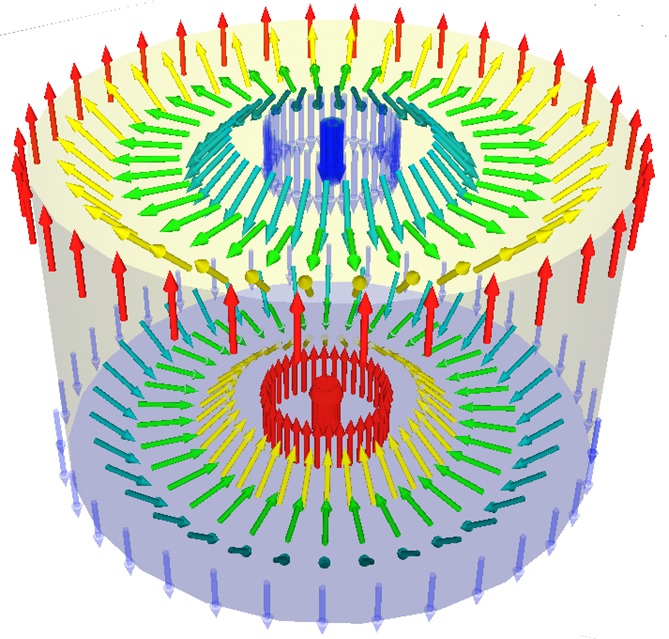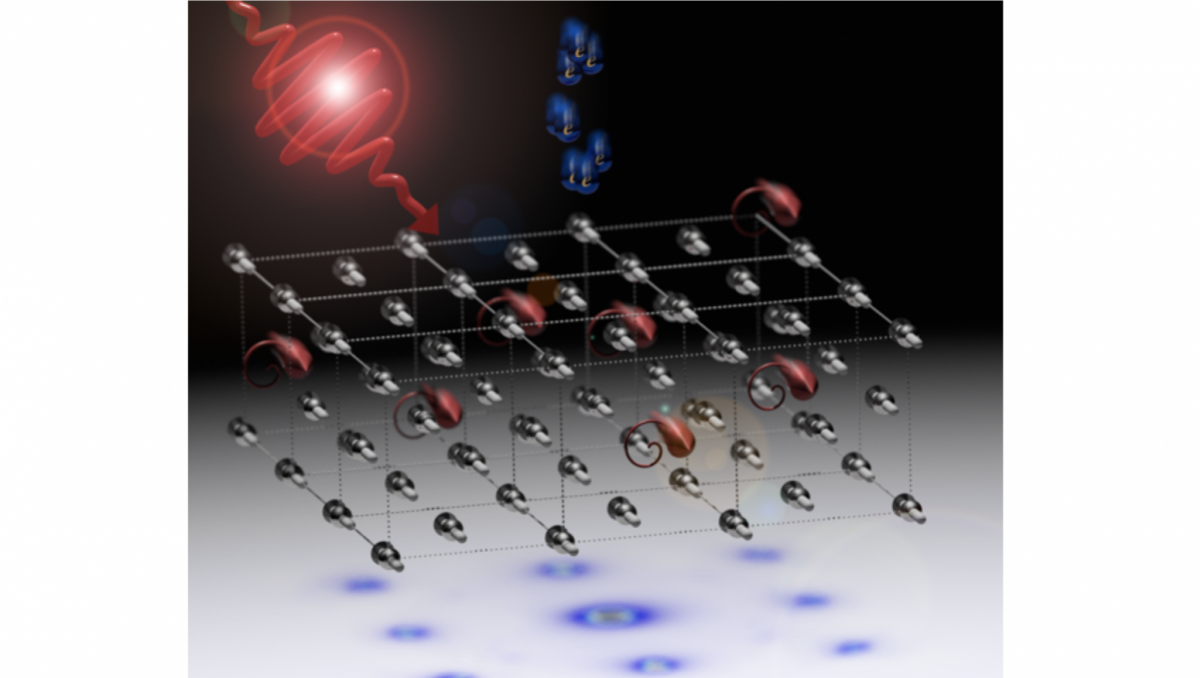
Press Release
29.11.2023
Noise – not a nuisance but a source of information
Researchers at the University of Konstanz discover a new type of ultrafast magnetic switching by investigating fluctuations that normally tend to interfere with experiments as noise.
Noise on the radio when reception is poor is a typical example of how fluctuations mask a physical signal. In fact, such interference or noise occurs in every physical measurement in addition to the actual signal. "Even in the loneliest place in the universe, where there should be nothing at all, there are still fluctuations of the electromagnetic field", says physicist Ulrich Nowak. In the Collaborative Research Centre (CRC) 1432 "Fluctuations and Nonlinearities in Classical and Quantum Matter beyond Equilibrium" at the University of Konstanz, researchers do not see this omnipresent noise as a disturbing factor that needs to be eliminated as far as possible, but as a source of information that tells us something about the signal.
No magnetic effect, but fluctuations
This approach has now proved successful when investigating antiferromagnets. Antiferromagnets are magnetic materials in which the magnetizations of several sub-lattices cancel out each other. Nevertheless, antiferromagnetic insulators are considered promising for energy-efficient components in the field of information technology. As they have hardly any magnetic fields on the outside, they are very difficult to characterize physically. Yet, antiferromagnets are surrounded by magnetic fluctuations, which can tell us a lot about this weakly magnetic material.
In this spirit, the groups of the two materials scientists Ulrich Nowak and Sebastian Gönnenwein analysed the fluctuations of antiferromagnetic materials in the context of the CRC. The decisive factor in their theoretical as well as experimental study, recently published in the journal Nature Communications, was the specific frequency range. "We measure very fast fluctuations and have developed a method with which fluctuations can still be detected on the ultrashort time scale of femtoseconds", says experimental physicist Sebastian Gönnenwein. A femtosecond is one millionth of a billionth of a second.
New experimental approach for ultrafast time scales
On slower time scales, one could use electronics that are fast enough to measure these fluctuations. On ultrafast time scales, this no longer works, which is why a new experimental approach had to be developed. It is based on an idea from the research group of Alfred Leitenstorfer, who is also a member of the Collaborative Research Centre. Employing laser technology, the researchers use pulse sequences or pulse pairs in order to obtain information about fluctuations. Initially, this measurement approach was developed to investigate quantum fluctuations, and has now been extended to fluctuations in magnetic systems. Takayuki Kurihara from the University of Tokyo played a key role in this development as the third cooperation partner. He was a member of the Leitenstorfer research group and the Zukunftskolleg at the University of Konstanz from 2018 to 2020.
Detection of fluctuations using ultrashort light pulses
In the experiment, two ultrashort light pulses are transmitted through the magnet with a time delay, testing the magnetic properties during the transit time of each pulse, respectively. The light pulses are then checked for similarity using sophisticated electronics. The first pulse serves as a reference, the second contains information about how much the antiferromagnet has changed in the time between the first and second pulse. Different measurement results at the two points of time confirm the fluctuations. Ulrich Nowak's research group also modelled the experiment in elaborate computer simulations in order to better understand its results.
One unexpected result was the discovery of what is known as telegraph noise on ultrashort time scales. This means that there is not only unsorted noise, but also fluctuations in which the system switches back and forth between two well-defined states. Such fast, purely random switching has never been observed before and could be interesting for applications such as random number generators. In any case, the new methodological possibilities for analyzing fluctuations on ultrashort time scales offer great potential for further discoveries in the field of functional materials.
Key facts:
- Original publication: M. A. Weiss, A. Herbst, J. Schlegel, T. Dannegger, M. Evers, A. Donges, M. Nakajima, A. Leitenstorfer, S. T. B. Goennenwein, U. Nowak & T. Kurihara: Discovery of ultrafast spontaneous spin switching in an antiferromagnet by femtosecond noise correlation spectroscopy. Nat Commun 14, 7651 (2023). doi.org/10.1038/s41467-023-43318-8
- By studying fluctuations, researchers at the University of Konstanz discover a new type of magnetic switching
- Project cooperation between materials scientists Professor Alfred Leitenstorfer, Professor Ulrich Nowak and Professor Sebastian Gönnenwein from the University of Konstanz, Associate Professor Makoto Nakajima from Osaka University and Dr. Takayuki Kurihara from the University of Tokyo
- The study was funded by the Collaborative Research Centre 1432.
Contact:
University of Konstanz
Communications and Marketing
E-Mail: kum@uni-konstanz.de
- uni.kn
___________________________________________________

Press Release
11.09.2023
Magnetic whirls pave the way for energy-efficient computing
International research collaboration involving the University of the Konstanz has been able to increase the diffusion of magnetic whirls – the skyrmions – by a factor of ten
In today's world, our lives are unimaginable without computers. Up until now, these devices process information using primarily electrons as charge carriers, with the components themselves heating up significantly in the process. As a result, active cooling is required, which comes with high energy costs. Spintronics aims to solve this problem: Instead of utilizing the electron flow for information processing, it relies on their spin – their intrinsic angular momentum. This approach is expected to have a positive impact on the size, speed and sustainability of computers.
Magnetic whirls store and process information
Science often does not simply consider the spin of an individual electron, but rather magnetic whirls composed of numerous spins. These whirls called skyrmions emerge in magnetic metallic thin layers and can be considered as two-dimensional quasi-particles. On the one hand, the whirls can be deliberately moved by applying a small electric current to the thin layers; on the other hand, they move randomly and extremely efficiently due to diffusion. The feasibility of creating a functional computer based on skyrmions was demonstrated by a team of researchers from Johannes Gutenberg University Mainz (JGU), led by Professor Mathias Kläui, using an initial prototype. This prototype consisted of thin, stacked metallic layers, some only a few atomic layers thick.
Energy efficiency: tenfold increase in whirl diffusion
As published in the current issue of Nature Communications, the University of Konstanz's research collaboration with Mainz University, Germany, and Tohoku University, Japan, has now achieved another step towards spin-based, unconventional computing: They were able to increase the diffusion of skyrmions by a factor of about ten using synthetic antiferromagnets, which drastically reduces the energy consumption and increases the speed of such a potential computer. "The reduction of energy usage in electronic devices is one of the biggest challenges in fundamental research", emphasized Professor Ulrich Nowak, who led the theoretical part of the project in Konstanz.
What is an antiferromagnet?
Normal ferromagnets consist of many small spins, all coupled together to point in the same direction, thereby creating a large magnetic moment. In antiferromagnets, the spins are aligned alternatingly antiparallel, i.e. a spin and its direct neighbours point in the opposite direction. As a result, there is no net magnetic moment, even though the spins remain antiferromagnetically well-ordered. Antiferromagnets have significant advantages, such as a thousand times faster dynamics for switching, better stability and the potential for higher storage densities.
Why use antiferromagnets?
When skyrmions move very rapidly, an additional force component arises in ferromagnetic layers perpendicular to the direction of motion. This force component pushes the skyrmions off course. Consequently, they collide with the wall, get stuck and obstruct the path for others. At higher speeds, they can even be destroyed. However, it is theoretically known that this effect either does not occur in antiferromagnets or it occurs to a very limited extent.
To artificially create such an antiferromagnet, the researchers coupled two of their ferromagnetic layers in a way that the magnetization in the two layers is precisely aligned in opposite directions, cancelling out their magnetic fields. This reduces the force that pushes the whirls out of their trajectory.
Stochastic computing
The researchers have created a synthetic antiferromagnet in which the diffusion of skyrmions is approximately ten times higher than in the individual layers. This diffusion can be implemented to realize stochastic computing – a form of computing where stochastic processes like the random motion of particles are utilized.
The role fluctuations play for the motion of skyrmions is studied in Konstanz in the context of the Collaborative Research Centre SFB1432. The interrelationships are complex, and only with the help of computer simulations is it possible to separate and thus understand the various effects that occur.
Key facts
- Original publication T. Dohi et al., Enhanced thermally-activated skyrmion diffusion with tunable effective gyrotropic force, Nature Communications, 11 September 2023, DOI: 10.1038/s41467-023-40720-0
- Research collaboration between the University of Konstanz, Johannes Gutenberg University Mainz, both Germany, and Tohoku University, Japan, could increase the diffusion of skyrmions by a factor of about ten using synthetic antiferromagnets, thus drastically reducing the energy consumption of spin-based non-conventional computing.
- Funded by the German Research Foundation (DFG) in the framework of the Collaborative Research Centre (SFB) "Fluctuations and Nonlinearities in Classical and Quantum Matter beyond Equilibrium" (SFB1432) at the University of Konstanz, SFB "Spin+X" (SFB/TRR 173) at the University of Kaiserslautern-Landau and the Johannes Gutenberg University Mainz, and by the Priority Programme SPP 2137: "Skyrmionics: Topological Spin Phenomena in Real-Space for Applications".
Contact:
University of Konstanz
Communications and Marketing
E-Mail: kum@uni-konstanz.de
- uni.kn
_________________________________________________

Press Release
02.02.2022
The puzzle of the "lost" angular momentum
A research team from Konstanz succeeds in solving a decade-old physical puzzle: the question of the fate of angular momentum during the ultrafast demagnetization of nickel crystals by laser light.
The solution to the puzzle was now published in the scientific journal Nature. In the study, a team led by Konstanz researchers investigated the demagnetization of nickel crystals using ultrafast electron diffraction – a highly precise measuring method in terms of time and space that can make the...
S. R. Tauchert, M. Volkov, D. Ehberger, D. Kazenwadel, M. Evers, H. Lange, A. Donges, A. Book, W. Kreuzpaintner, U. Nowak, P. Baum:
Polarized phonons carry angular momentum in ultrafast demagnetization,
Nature 602, 73–77 (2022)
